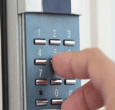
With access control systems, companies have a greater level of freedom while arguably restricting that of their employees. Yet in the world of modern business with each organization seeking an advantage (even an unfair one) over their rivals, it makes sense for companies to be as secure as possible. Access control systems are designed to prevent so-called ‘inside jobs’ where current or former employees steal important information and sell it to a competitor. These systems usually involve restricting access to certain areas by inserting barriers that can only be bypassed with the right credentials.
All access control systems are computerized and keep a record of who entered a certain area as well as the time they entered and exited. The most basic access control systems consist of a keypad which controls a single door. This is in turn connected to central control system which decides whether the entrant is authorized to go any further. There is also the possibility of utilizing this system as a means of tracking employees to ensure they are on time.
Basic Equipment
Access control systems are made up of several key elements. Keypads are the most basic component but also the least secure. Even though it requires a specific code to bypass, employees often give this code to someone else, automatically reducing its effectiveness. There are also card readers which are again, not that secure because cards are easily lost. Although it is easy to deactivate the cards and make new ones, this is a time consuming process. Smartcards are more sophisticated as they hold an employee’s information but are rarely used due to the expense and difficulties involved in the setup.
Proximity cards are gaining in popularity. These cards automatically open a door once they are within a couple of feet or inches (depending on the card). These cards are inexpensive and survive wear and tear because the user does not even have to take it out from his/her bag. There are also biometric systems which involve scanning the user’s eyes or fingerprints. This is one of the most secure options but it is also extremely expensive and employees may not appreciate undergoing such a procedure on a regular basis.
Locking Systems
You need a security system that electronically controls locks with magnetic locks and electric strikes the two main methods of locking doors used. Electric strikes are a good option for steel or wooden doors while magnetic locks work best with glass and aluminum doors. You should look for hardware with sensors that are aware when a door is open and immediately sends an alarm signal if the door is opened by someone lacking the requisite clearance details. The alarm could also be set to sound if the door stays open for too long. There are also access control systems designed to restrict vehicle access. These come in full-door openers that resemble a garage door and swinging or sliding gates.
Software
When choosing access control systems, it is important to distinguish between the different software vendors use. Basic software will enable you to create your own access levels for different parts of the building and record details relating to who used the door at certain times. Never purchase a system without having a trial run of the software first. It should reduce your administrative problems, not increase them. The software should make it easy to add or remove employees and alter access levels. The majority of access control systems on the market have the ability to cope with the needs of up to 1,000 employees.
Getting Value For Money
There are numerous other features that should be considered by companies. Low-end access control systems are very basic in their operation and provide a level of security that is far from watertight. The aforementioned card reader and keypad problems are examples of this. There is no point spending a small fortune on a system that can easily be bypassed because an employee lost their card or wrote down their access code. These low-end systems cost approximately $1,500 a door. For this sort of expense, you should be receiving a higher level of security.
High-end systems seem excessively expensive but in reality, the cost is a drop in the ocean for multi-million dollar organizations. Biometric equipment including iris scanning may cost up to $10,000 a door but it is virtually impossible to manipulate this system. High-end access control systems also come with a host of additional extras.
For example, you can purchase a system that allows you to choose a time for the door to lock or unlock. You will also have a battery backup in the event of a power failure. Low-end systems may not have this option, rendering them useless if a power outage occurs. It is even possible to purchase systems with voice communication which allows visitors to converse with a central booth and perhaps gain access.
Access control systems are an increasing phenomenon with organizations keen to prevent employees from committing internal theft. These systems also ensure that members of the public are not able to accidentally end up in unauthorized areas. With millions of dollars at stake, having doors with ‘staff only’ written on them is no longer good enough. Profitable organizations with wealth and secrets to protect must up their security to stay safe and access control systems provide precisely the level of protection they require.
